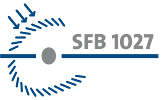|
Alice Abend
|
Research Group Biotechnology and Biomedicine, Peter Debye Institute for Soft
Matter Physics, Faculty of Physics and Earth Sciences, Leipzig University, Leipzig, Germany |
Adhesion dynamics and organization of neurons
and glial cells on nanocolumnar TiN substrates
|
|
Massimiliano Anselmi
|
Theoretical Physics, Saarland University, Saarbrücken, Germany |
Do the Loops in the N-SH2 Binding Cleft Truly Serve
as Allosteric Switch in SHP2 Activation?
|
| Athullya Baby
|
Turing Center for Living systems, Marseille, France |
Generation of Fluid Flows On The Skin of Xenopus Embryo |
|
Mehrnaz Babaki
|
Biomacromolecular Systems and Processes (IBI-4), Forschungszentrum Jülich GmbH,
Jülich, Germany and Laboratory for Soft Matter and Biophysics, KU Leuven, Leuven,
Belgium
|
Shape deformation of RBCs in a doublet |
|
Robert A. Becker
|
Department of Theoretical Physics, Universität des Saarlandes, Saarbrücken, Germany
|
A continuous complete RNA translocation cycle by the DEAH-box helicase
Prp43 in atomic detail |
|
Ramachandra M. Bhaskara
|
Institute of Biochemistry II (IBC2), Faculty of Medicine, Goethe University, Buchmann Institute for Molecular Life Sciences (BMLS),
Goethe University and Department of Theoretical
Biophysics, Max Planck Institute of Biophysics, Frankfurt am Main, Germany |
Molecular events during selective ER-phagy
|
|
Eliane Blauth
|
Peter Debye Institute, Soft Matter Physics Department, Leipzig, Germany |
Fatty Connective Tissue Interaction changes Cancer
Cell Mechanics
|
|
Shardul Bhusari
|
INM Leibniz Institute for New Materials and
Chemistry Department, Saarland University, Saarbrücken, Germany
|
Design of 3D printed hydrogel biofilm mimics
|
|
Alexis Darras
|
Experimental Physics, Saarland University; Saarbrücken, Germany
|
Red blood cell deformability in erythrocyte
sedimentation
and in vivo partitioning
|
|
Anil Kumar Dasanna
|
Theoretical Physics of Living Matter, IBI-5 and IAS-2, Forschungszentrum Jülich, Jülich and
Center for Biophysics (ZBP) and Department of Theoretical Physics, Saarland University, Saarbrücken, Germany
|
Stochastic bond dynamics induce optimal alignment of malaria
parasite
|
|
Priyanka Dhakane
|
INM – Leibniz-Institute for New Materials, Saarbrücken, Germany
|
Photoswtichable ICAM1 for immunological synapse
studies
|
|
Alessandro Falconieri
|
Department of Biology, University of Pisa, Pisa, Italy
|
Mechanotransduction of axonal growth: a journey from microtubules
to local phenomena
|
|
Dmitry A. Fedosov
|
Institute of Biological Information Processing and Institute for Advanced Simulation,
Forschungszentrum Jülich, Jülich, Germany
|
Sculpting vesicles with active particles
|
|
Sadegh Ghorbani
|
Interdisciplinary Nanoscience Center (iNANO) and CellPAT Center, Aarhus University, Aarhus C, Denmark
|
Hemidesmosome-like Adhesion Mimicked through Nanopatterning of Laminin-332
|
|
Alessandra Griffo
|
Department of Experimental Physics, Saarland University, Saarbrücken, Germany
|
Biomechanics and architecture of unsupported and biomimetic lipid
membranes: insights on geometrical constrains and lipid chemistry
|
|
Ivan Hornak
|
Saarland University, Department of Theoretical Physics, Center for Biophysics, Saarbrücken, Germany
|
Stochastic model of T Cell repolarization with two immunological
synapses
|
|
Sandra Iden
|
Cell and Developmental Biology, Center of Human and Molecular Biology (ZHMB),
Saarland University, Faculty of Medicine, Homburg/Saar,
Cologne Excellence Cluster on Cellular Stress Responses in Aging-Associated Diseases
(CECAD), University of Cologne,
Center for Molecular Medicine Cologne (CMMC), University of Cologne, Germany
|
Lrig1 and Wnt signaling instruct partitioning of
melanocytes and resident immunocytes into distinct
epidermal niches
|
|
Cécile Jebane
|
Aix Marseille Univ, CNRS, CINAM, Turing Centre for Living systems, Marseille, France
|
Premature senescence by lamin A/C alterations
correlates to changes in cell viscoelastic behavior
|
|
K. Kaub
|
Max Planck School Matter to Life, Georg-August Universität Göttingen, Germany
|
Differential microrheological properties of actin isoforms
|
|
Hans Kubitschke
|
Peter Debye Institute, Soft Matter Physics Department, Leipzig, Germany
|
Connective Tissue and Cancer Cross-Talk:
Treatment Implications and Biomechanical Signature?
|
|
Clara Ramón-Lozano
|
LadHyX, CNRS, École polytechnique, Institut polytechnique de Paris, Palaiseau, France
|
Brain microvascular endothelial cell cytoskeletal reorganization in
response to strain in a microvessel-on-chip
|
|
Erik Maikranz
|
Department of Theoretical Physics, Saarland University, Saarbrücken, Germany
|
Theoretical modelling of competitive microbial range
expansion with heterogeneous mechanical interactions
|
|
Sylvain Monnier
|
Institut Lumière Matière, UMR5306, Université Lyon 1-CNRS, Université de Lyon,
Villeurbanne, France
|
Probing cell volume in compressed tissues with Brillouin
light scattering
|
|
Cornelia Monzel
|
Experimental Medical Physics, Heinrich-Heine University Düsseldorf
|
Elucidating Receptor Cluster Formation in CD95
Signaling
via DNA Origami and Multiparametric Image
Spectroscopy
|
|
Zahra Mostajeran
|
Leibniz Institute for New Materials, Saarbrücken, Germany
|
The influence of vimentin on actin dynamics and force generation in RPE1 cells
|
|
Malèke Mouelhi
|
Institute of Light and Matter (ILM), Univ. Lyon, Univ. Claude Bernard Lyon 1, France
|
Long-term nuclear regulation of cancer cells under confinement
|
|
Tanja Neumann
|
JPK BioAFM, Bruker Nano GmbH, Am Studio 2D, 12489 Berlin, Germany
|
Unravelling the Mechanobiology of Living Cells while
Interacting with their Environment
|
|
Peter Nietmann
|
Janshoff Group, University of Göttingen, Institute of Physical Chemistry, Germany
|
Nonequilibrium mechanics of cross-linked
actomyosin networks probed with
microrheological techniques
|
|
Diana B. Peckys
|
Clinic of Operative Dentistry, Periodontology and Preventive Dentistry, Saarland
University, Homburg, Saar, Germany
|
Quantitative Study of Heterogeneity in Membrane
Protein Interaction in Cancer Cells using Liquid-Phase
Electron Microscopy
|
|
Cas van der Putten
|
Department of Biomedical Engineering, Eindhoven University of Technology, The
Netherlands
|
Understanding cell behavior in complex multi-cue
environments
|
Tanmoy Sarkar
|
Department of Biomedical Engineering, Ben-Gurion University of the Negev, BeerSheva, Israel |
A minimal lattice model of lipid membranes with liquidordered domains |
|
Laura Schaedel
|
Institute for X-Ray Physics, University of Göttingen, Germany
|
Vimentin Intermediate Filaments Stabilize Dynamic
Microtubules by Direct Interactions
|
|
M. A. Ramirez Sierra
|
Frankfurt Institute for Advanced Studies (FIAS), Frankfurt am Main, Germany
|
Spatial-Stochastic Model of Cell Fate Decisions in Early Mouse Development
|
|
Ewa Sitarska
|
Cell Biology and Biophysics Unit, European Molecular Biology Laboratory, Heidelberg, Germany
|
Sensing their plasma membrane curvature allows migrating cells to circumvent obstacles
|
|
Thomas R. Sokolowski
|
Frankfurt Institute for Advanced Studies (FIAS), Frankfurt am Main, Germany, and
Institute of Science and Technology Austria (IST Austria), Klosterneuburg, Austria
|
Rationalizing the optimality of the gap gene system by ab-initio derivation of optimalensembles of morphogenetic patterns
|
|
Barbara Schmidt
|
Center for Biophysics and Department of Theoretical Physics, Saarland University, Saarbrücken,
Germany
|
BK-channel as a fast and precise Ca2+ sensor: application to PMCA
pump strength measurements
|
|
M.D’Urso
|
Department of Biomedical Engineering and
Institute for Complex Molecular System, Eindhoven University of Technology,
Eindhoven, Netherlands
|
Quantitative biophysical characterization of
fibroblast activation
|
|
Andreas Weber
|
Institute for Biophysics, Department of Nanobiotechnology, University of Natural
Resources and Life Sciences Vienna (BOKU), Muthgasse 11, Vienna, Austria
|
A-to-I RNA editing of Filamin A (FLNA) regulates
cellular adhesion, migration and mechanical properties
|
Adam Wysocki
|
Department of Theoretical Physics and Center for Biophysics, Saarland University,
Saarbrücken, Germany
|
Collective Search Strategies
|









